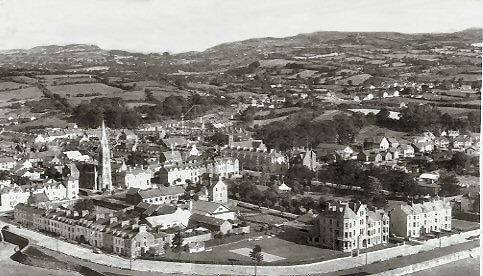The highest mountain on the Ring of Gullion is the elongate Camlough which on its eastern end sweeps towards Derrymore and Althaveigh until it merges with the Bernish at Cloughogue. On the far side of the main Dublin Road Fathom Mountain sweeps east and south.
Those mountains that define the horizon from the beach at Warrenpoint are different both in aspect and indeed in constituent minerals, origin and date of intrusion and emergence to the surface. Anglesey Mountain is behind Omeath and has a very scenic drive up past the Long Woman’s Grave. That’s a story I have yet to tell you! It merges at its southern end with Carlingford’s Slieve Foye. This is all our natural hinterland, but again a story for another day.
The Ring doubles back through Clontygora to cross the ‘border’ at Derryhale. The fortified hilltops in that vicinity are evidence enough of the limits of political jurisdiction.
The Ring is completed with Aughnaduff Mountains, Slievenacappal, Croslieve, Slieve Brack [at Forkhill], Mullaghbane Mountain, Lislea or Courtenay Mountain, Sugarloaf Hill, Sturgan Mountain and Carrigan’s Hill. The hilly road that climbs from the northern end of Camlough Lake is called Sturgan Brae – always I thought, a beautiful name incorporating the Gaelic into one’s everyday language. If one had still to climb it by Shank’s mare, or horse and cart, one would have time enough and to spare, to drink in the wonders of nature that are all around.
Slieve Gullion, the remains of a long-extinct and collapsed volcano is in the centre and is the highest point. Its ‘tail’ at Drumintee points towards Forkhill.
Within the Ring [see map elsewhere here] there is a sizable extent of intrusive Newry Granite and the ring itself is mainly of grantitic composition. There is a little disused quarry on the road from Camlough to Meigh, beside a scenic amenity site that overlooks the beautiful lake from a height of 100 metres, where one can see clearly – because of different coloration – where distinctly different intrusions [both of composition and time] have emerged close to the surface. [I ruined a good pair of trousers on trailing briars, investigating this information for you – so consider yourself warned!].
Does every hill have a name? For dear’s sake, it’s not so long ago that every field had a name, as well as every farm animal.
Ought we all not to slow down a little?
